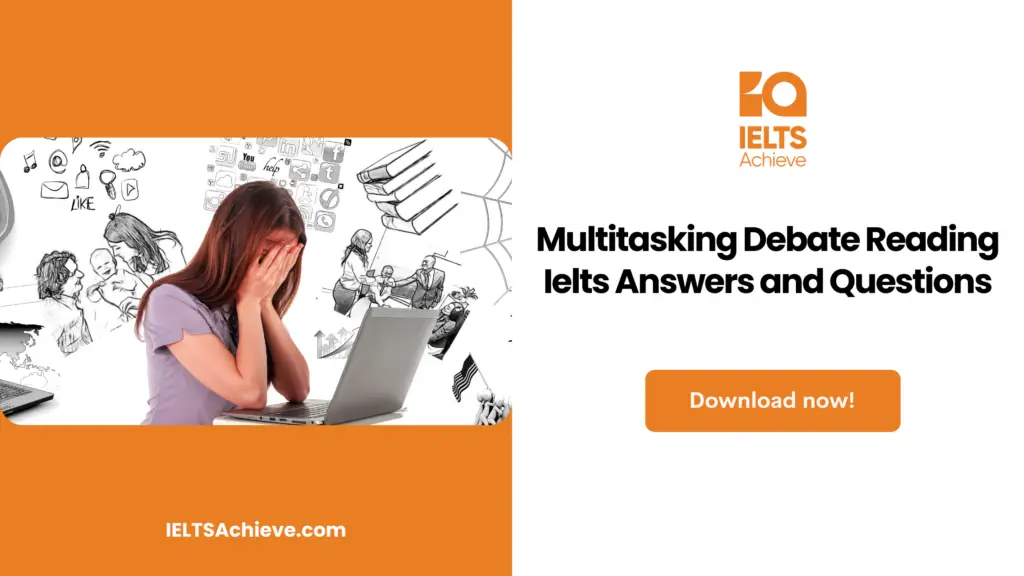The Blog post contains the following IELTS Reading Questions:
- IELTS reading locating information
- IELTS reading multiple choice questions
- IELTS reading yes no not given
Stay informed and prepared for success – Explore our comprehensive Reading Test Info page to get valuable insights, exam format details, and expert tips for mastering the IELTS Reading section.
IELTS Reading Passage: Multitasking Debate

Multitasking Debate
Can you do them at the same time?
We’re not as good at multitasking as we’d like to think we are, and it’s not just limited to talking on the phone while driving. Those who claim that human beings are inherently unable to multitask on account of a bottleneck in our brains should read the latest research. People who believe they are multitasking are, if research results are any indication of real-world performance, likely performing poorly in all but one of their activities. Even if you practice a lot, you won’t perform as well as you can when you’re only thinking about one thing at a time.
René Marois, a psychologist at Vanderbilt University in Nashville, Tennessee, claims that the issue is due to a mental roadblock. That’s why Marois came up with an experiment to find it: to prove his point. Subjects are asked to keep their eyes on the screen and use their index finger to push a key whenever a specific image appears, such as a red circle. You’ll need to use different fingers to press the various colored circles. The volunteers typically reach their peak performance in less than a minute. Then, participants are instructed to listen to various recordings and replicate the sound they hear. For example, students need to say “ba” when they hear a bird chirp, “ko” when they hear an electronic sound, and so on. Again, it’s not an issue. You can achieve that in less than a second with very little effort if you are a regular human being.
The problem arises when Marois displays an image to the test subjects and then immediately plays a sound. They have been completely thrown off guard. As he puts it, “one duty is postponed” when visuals and audio are presented simultaneously. In reality, the second task will be put on hold until the first is finished if it is introduced inside the half second or so it takes to process and react to the first. Delays caused by performing two tasks at once are greatest; conversely, they decrease with increasing time between the two activities being given.
According to Marois, there are at least three snags. The first challenge is in understanding what we are seeing. Because of the time required (which can be several hundred milliseconds), we miss out on the opportunity to take in and identify a second object. Experiments have demonstrated that if you are keeping an eye out for a specific event and another event unexpectedly appears during this critical window of concentration, you may recognize it in your visual cortex. Still, you will be unable to act on it. It’s interesting to note that if you don’t anticipate the first occurrence, you’ll have no trouble reacting to the second. The root of the attentional lapse remains a mystery.
Furthermore, our ability to retain visual information for the long term is severely compromised. Keeping track of more than four things at once is difficult for most people, and even more so with complex tasks. Our remarkable failure to identify even massive changes in otherwise identical scenes (so-called “change blindness”) is widely believed to be at least partially because of this capacity deficiency. People are unable to tell the difference between two images that are nearly identical save for one small detail, such as the absence of airplane engines in one photo. As before, though, opinions differ as to what exactly constitutes the primary bottleneck. Is there a lack of space for data storage, or is it more about the viewer’s focus?
A third restriction is that it takes mental effort to decide how to react to an event, such as stopping the car when you spot a child in the road or responding to your mother’s phone call in which she announces her intention to divorce your father. Your capacity to react to the other will be slowed by a few tenths of a second as you decide how to handle the first. The term “response selection bottleneck” was coined to describe this concept in 1952.
One psychologist at the University of Michigan in Ann Arbor named David Meyer disagrees with the bottleneck theory. The inability to perform two tasks at once, in his opinion, is just the brain’s way of establishing priorities. Meyer is known as an optimist in his circle of friends. In one of his studies, he explains how to “uncork the fundamental cognitive bottleneck” by analyzing the effects of simultaneous task performance on a person’s ability to multitask. His research shows that after at least two thousand repetitions, some people can perform two activities concurrently with the same level of proficiency as if they were performed sequentially. He posits the existence of an overarching cognitive processor that handles all of this, and he goes so far as to claim that this processor exercises discretion by, for example, delaying the completion of one job in order to focus on another.
In some cases, Marois says, practice can eliminate interference effects. Volunteers exhibit significant improvement after only two weeks of practice, with just one hour per day of instruction. This is an area where he differs from Meyer; he thinks the brain is doing something other than what Meyer claims. According to Marois, with enough repetition, our brains may develop “subconscious circuits” for carrying out a task, much like drivers who are familiar with the area might find reliable back ways to avoid heavy traffic on main roads. Walking while talking, eating while reading, and watching TV while folding laundry is just a few examples of subconscious multitasking that most of us often engage in.
It’s hardly shocking to learn that our ability to multitask declines with age. University of Illinois at Urbana-Champaign researcher Art Kramer claims that our apex is reached in our twenties when it comes to our cognitive capacity. There is a gradual drop beginning in our thirties that continues through our fifties, and then a more rapid decline beginning at age 55. One experiment he and his team conducted involved having participants of varying ages simulate driving while also having a chat. He discovered that older drivers failed to see things that were very relevant, while younger drivers missed changes in the background. Similarly, compared to younger drivers, older respondents had problems focusing on what was most crucial in a scene.
However, it’s not all bad news for those 55 and up. Kramer also discovered that the procedure benefited senior citizens. They improved their performance, and brain scans revealed that the reason was a shift in how their brains become active when performing the task at hand. The core facts remain sobering, despite the obvious reality that practice may often make a difference, especially as we age. According to Marois, despite the widespread belief that human beings possess a “superior, complex brain,” these individuals actually face “extremely humbling and crushing restrictions.” He argues that humans have not evolved to be multitaskers because, throughout most of our existence, we have had no need to. In any case, perhaps in the not-too-distant future, we shall see. The likes of Debbie and Alun may one day be seen as the forebears of a new kind of super-efficient worker.
Unlock your full potential in the IELTS Reading section – Visit our IELTS Reading Practice Question Answer page now!
Recommended Questions:
Renewable Energy IELTS Reading Question with Answer
Multitasking Debate IELTS Reading Questions
Questions 1-5
The Reading Passage has ten paragraphs A-J. Which paragraph contains the following information? Write the correct letter A-J, in boxes 1-5 on your answer sheet.
- When competing audiovisual elements appear at the same time, conflicts arise.
- There are noticeable differences in how various age groups react to significant events.
- There is a time lag, according to a notion, when deciding which action to do.
- At least one point of view gives the advantages of multitasking a favorable slant.
- The purpose of this experiment is to show what region of the brain is most important when juggling many tasks.
Questions 6-8
Choose the correct letter, a, b, c, or d. Write your answers in boxes 6-8 on your answer sheet.
6. Which one is correct about the experiment conducted by René Marois?
- Blending visual and auditory data, they pulled off a superior ruse
- There is a necessity for participants to utilize a variety of fingers on various objects.
- Participants use the keys in a variety of colors to press a variety of responses.
- The listening task was the only one in which participants did poorly.
7. Which statement or experiment conducted by Meyer is NOT correct?
- The first restriction is circumventable with the right preparations.
- We can never seem to get past the second one.
- If we are focused on the first object when the second one appears, we will experience a delay.
- A “blink of attention” lasts roughly ten seconds.
8. Which statement is correct concerning the first limitation of Marois’s experiment?
- Existing hardware evaluates whether to pause one job in favor of completing another.
- Meyer disagrees with Marois’ theory.
- Eventually, with practice, you’ll be able to multitask without sacrificing quality.
- People are only able to successfully multitask after numerous failed tries.
Ready to improve your performance in Multiple Choice Questions (MCQs)? Click here to access our comprehensive guide on how to tackle MCQs effectively in the IELTS Reading section.
Questions 9-13
Do the following statements agree with the information given in Reading Passage? In boxes 9-13 on your answer sheet, write
YES if the statement is true
NO if the statement is false
NOT GIVEN if the information is not given in passage
9. However, Marois disagrees with the idea that training can eliminate the bottleneck.
10. It is the author’s opinion that practice has no bearing on the outcome and hence cannot result in a change.
11. When one job is presented after another, the time between them decreases.
12. A gender difference in the ability to multitask was demonstrated by Art Kramer.
13. Humans’ memory flaws often lead them to confuse two seemingly identical pictures.
Want to excel in identifying the writer’s views and claims? Click here to explore our in-depth guide on how to accurately determine Yes, No, or Not Given in the IELTS Reading section.
Unlock your full potential in the IELTS Reading section – Visit our IELTS Reading Practice Question Answer page now!
Recommended Questions:
Renewable Energy IELTS Reading Question with Answer
Multitasking Debate Reading Answers
1. C
2. I
3. F
4. G
5. B
6. b
7. c
8. d
9. No
10. No
11. Yes
12. Not Given
13. Yes

We hope you found this post useful in helping you to study for the IELTS Test. If you have any questions please let us know in the comments below or on the Facebook page.
The best way to keep up to date with posts like this is to like us on Facebook, then follow us on Instagram and Pinterest. If you need help preparing for the IELTS Test, join the IELTS Achieve Academy and see how we can assist you to achieve your desired band score. We offer an essay correction service, mock exams and online courses.

